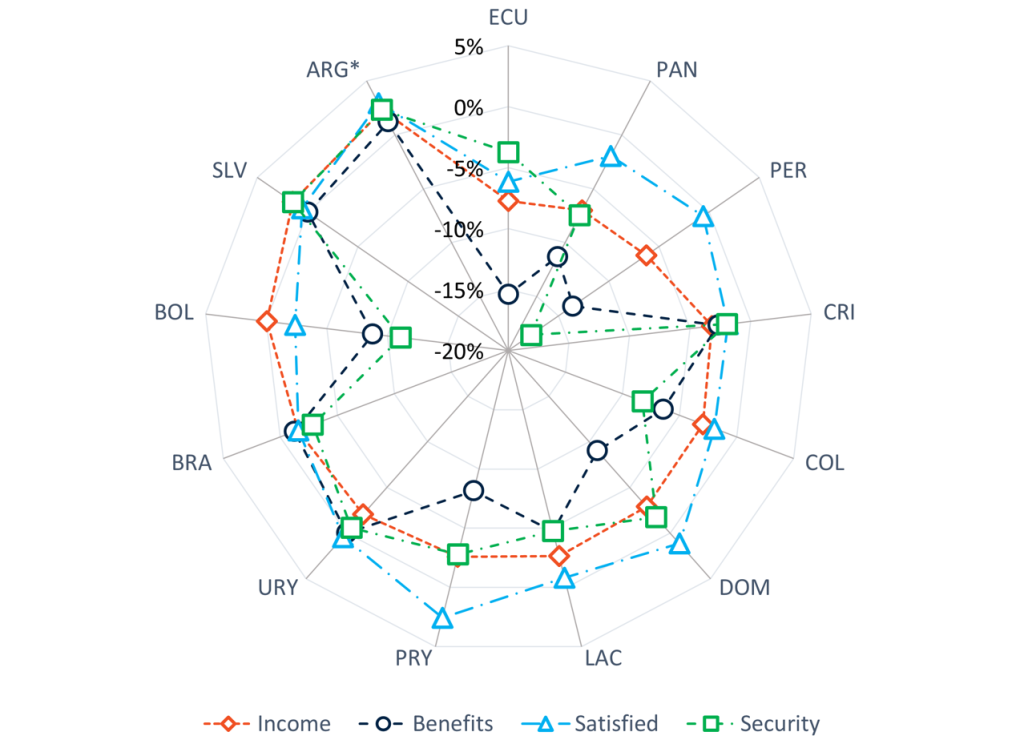 Vendedor cuenta dinero en un negocio pequeño en Buenos Aires
Vendedor cuenta dinero en un negocio pequeño en Buenos Aires
Latin America and the Caribbean (LAC) found itself harder hit by global crises than most regions . In 2020, its economy contracted by 6.4 percent, with job losses affecting 8.3 percent of the workforce. Despite government efforts to cushion the shock, excluding Brazil, around 19 million people fell back into poverty, and 13.2 million moved out of the middle class.
The report From Infection to Inflation: Global crises hit hard poor households in Latin America and the Caribbean takes stock of these global sequential crises´ short- and long-term impacts. It reveals that these phenomena have partially redefined the poverty landscape of the region as urban areas and the middle class were sequentially affected. Here are four key trends for policy action:
- Education recovery was insufficient in 2021 to regain losses and heal long-lasting scars left by the pandemic. Without cohesive evidence-based learning recovery programs, there is a high risk that a whole generation who experienced school closures during the pandemic could see their lifetime earnings reduced by 12 percent.
- Inflation is reaching households. The context made it hard for families to cope with an average 8.9 percent jump in fuel and food prices following the outbreak of conflict in Ukraine. This additional inflation would have caused an increase of 1.3 percentage points in the poverty rate at $6.85 a day (2017 PPP), equivalent to almost 7 million more poor people in the region.
- There is a continuous deterioration in the living standards of vulnerable groups like women, the youth, and unskilled workers. COVID-19 saw many in these groups either reduce their consumption of food and other essential goods or eat into their savings. In both cases, this reduced their ability to respond to inflationary trends sparked by the Ukraine conflict. The burden of additional care duties on women during the pandemic could also lead to a prolonged reversal in female labor participation.
- The performance of the labor market will be critical to the capacity of poor households in LAC to recover due to limited fiscal headroom. For low-income families, labor income represents around 84 percent of their total income, on average, and is still below pre-pandemic levels in most countries, as shown in Figure 1-Panel A. With a weak economic outlook predicted for 2023, around 1.5 million jobs are expected to be created this year . However, job quality has experienced a decline since the onset of COVID-19, offsetting the benefits of increased employment (Figure 1 – Panel B). Below-inflation wage increases further negatively affect labor income, which is projected to remain 3 percent below pre-pandemic levels.
Figure 1. The quality of jobs has deteriorated, and labor income still lags behind pre-pandemic levels
Panel A. Change in labor income, relative to 2019

Panel B. Change in dimensions of Job Quality Index 2021 vs. 2019

The report holds out hope for a transition to a green economy. LAC enjoys a comparative advantage in low-carbon growth, which, if executed successfully, could create quality jobs, strengthen labor incomes, and contribute to overall poverty reduction. Placing a priority on reskilling and human capital development will be essential if low-income workers are to recover from these unexpected external shocks and seize the opportunities presented by the green transition.
These trends will exacerbate long-term inequality unless addressed directly. Policymakers, therefore, need to consider a range of interventions to address both the short- and long-term impacts of these multiple shocks in core areas such as education, infrastructure, financial services, and global market integration.
To receive weekly articles, sign-up here
Related articles



Join the Conversation